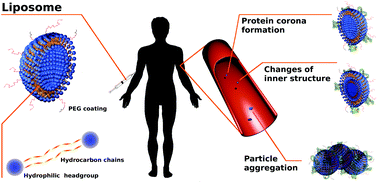当前位置:
X-MOL 学术
›
Biomater. Sci.
›
论文详情
Our official English website, www.x-mol.net, welcomes your
feedback! (Note: you will need to create a separate account there.)
Impact of the biomolecular corona on the structure of PEGylated liposomes†
Biomaterials Science ( IF 5.8 ) Pub Date : 2017-06-19 00:00:00 , DOI: 10.1039/c7bm00387k Luca Digiacomo 1, 2, 3, 4, 5 , Daniela Pozzi 1, 2, 3, 4 , Heinz Amenitsch 6, 7, 8, 9 , Giulio Caracciolo 1, 2, 3, 4
Biomaterials Science ( IF 5.8 ) Pub Date : 2017-06-19 00:00:00 , DOI: 10.1039/c7bm00387k Luca Digiacomo 1, 2, 3, 4, 5 , Daniela Pozzi 1, 2, 3, 4 , Heinz Amenitsch 6, 7, 8, 9 , Giulio Caracciolo 1, 2, 3, 4
Affiliation

|
Driven by the promises of gene therapy, PEGylated cationic liposomes (CLs) have been investigated for decades, but their use in the clinical setting is far from established. Such a dichotomy is due to several factors that have been ignored over the last two decades. The hardest challenge seems to occur when PEGylated CLs come into contact with a physiological environment (e.g. the blood). Recent evidence has demonstrated that PEGylation does not completely prevent protein binding (as believed so far), but a biomolecular shell, termed “biomolecular corona” (BC), covers the liposome surface. Here we show that the formation of a BC not only affects the surface properties of PEGylated CLs, but also, and significantly, their bilayer structure thus impairing their ability to safely deliver their cargo to the target site. Therefore, a mechanistic understanding of the structures emerging from liposome–protein interactions may represent a truly new paradigm for the clinical translation of PEGylated CLs.
中文翻译:

生物分子电晕对聚乙二醇化脂质体结构的影响†
受基因治疗前景的驱动,聚乙二醇化阳离子脂质体(CLs)已有数十年的研究历史,但在临床上的应用还远未建立。这种二分法是由于过去二十年中被忽略的几个因素造成的。当PEG化的CL与生理环境接触时,最困难的挑战似乎发生了(例如血液)。最近的证据表明,聚乙二醇化不能完全阻止蛋白质的结合(到目前为止,人们一直认为),但是被称为“生物分子电晕”(BC)的生物分子壳覆盖了脂质体的表面。在这里,我们表明BC的形成不仅影响PEG化CL的表面特性,而且显着影响其双层结构,从而损害其将货物安全运送到目标位置的能力。因此,对脂质体-蛋白质相互作用中出现的结构的机械理解可能代表了PEG化CL的临床翻译的真正新范例。
更新日期:2017-06-19
中文翻译:

生物分子电晕对聚乙二醇化脂质体结构的影响†
受基因治疗前景的驱动,聚乙二醇化阳离子脂质体(CLs)已有数十年的研究历史,但在临床上的应用还远未建立。这种二分法是由于过去二十年中被忽略的几个因素造成的。当PEG化的CL与生理环境接触时,最困难的挑战似乎发生了(例如血液)。最近的证据表明,聚乙二醇化不能完全阻止蛋白质的结合(到目前为止,人们一直认为),但是被称为“生物分子电晕”(BC)的生物分子壳覆盖了脂质体的表面。在这里,我们表明BC的形成不仅影响PEG化CL的表面特性,而且显着影响其双层结构,从而损害其将货物安全运送到目标位置的能力。因此,对脂质体-蛋白质相互作用中出现的结构的机械理解可能代表了PEG化CL的临床翻译的真正新范例。











































 京公网安备 11010802027423号
京公网安备 11010802027423号